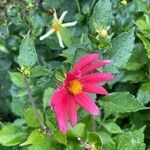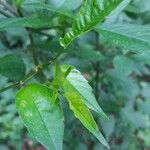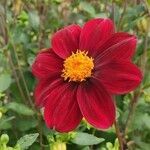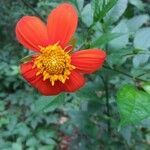Erect or somewhat lax perennial herb, up to c. 1.5 m tall, with tuberous roots. Stems glabrous or sparsely clothed in short hairs, branched above at flowering, dying back to tubers in winter. Lower cauline lvs petiolate, glabrous or sparsely clothed in short hairs, simple or 1-2-pinnate with 2-3 primary pairs and each of lowest pair with 1-5 leaflets; petiole with 2 lateral angles or short wings on upper surface; leaflets mostly not lobed, sometimes 2-3-lobed, sessile, ovate to elliptic, acute to acuminate, coarsely serrate, 5-15-(25) cm long. Upper cauline lvs 3-foliolate or simple. Capitula c. 5-15 cm diam., erect or horizontal. Outer involucral bracts (4)-5-(7), glabrous, elliptic-obovate to spathulate, 15-25 mm long, recurved at anthesis; inner bracts 8, ovate-triangular, usually membranous at margin, 15-25 mm long. Receptacular scales ovate-triangular, obtuse to subacute. Ray florets 8-numerous; ligules yellow, orange, pink to deep red, or pale to deep purple. Disc florets numerous or partly or wholly replaced by ligulate florets, yellow, orange or tinged red. Achenes linear-oblong, or somewhat broader toward apex, 12-15 mm long; pappus 0 or of reduced awns < 0.5 mm long.
More
A daisy family plant with a tuberous root. It grows 2-3 m high and spreads 0.6-1.2 m wide. It is one of the main parents of the modern Dahlia. The leaves are divided 3 times and are dark green but often with a purple tint. The leaflets are oval and have teeth. The flower heads are clustered with 2 or 3 together. They can be yellow, red or purple.
The flowers are used in salads. Also they are used in cream, cheese, dahlia dip and sundried tomto and dahlia bread.







